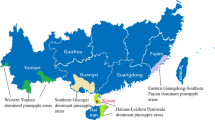Abstract
Immature inflorescences of ten rye inbred lines (inbred degree S10 and S11) were cultured on solidified MS medium supplemented with 3.0 mg/dm3 of 2,4-D. According to their capability for callus production explants were classified into two groups : responsive (giving weak or intensive callus production) and non responsive (lack of callus formation). After transferring responsive material into hormone-free medium the regeneration of roots or shoots from the intensive growing callus was observed. Consistent differences between lines in the portion of explants with a certain response were found. They were divided into five groups reacting in the same way. Lines with different in-vitro response were crossed in an incomplete diallel. F1, F2 and F3 generations were analyzed and the following conclusions drawn: the ability for plant regeneration from immature inflorescences in rye is determined by numerous loci, has a recessive character, and both callus production and regeneration suppression may be controlled by complementary genes.
Similar content being viewed by others
References
Broda Z (1984) Red clover (Trifolium pratense) vegetative propagation by tissue cultures with special consideration of genetic conditioning of the ability to regenerate from callus. Rocz Akad Roln Poznan Rozpr Nauk 140:5–40
Charmet G, Bernard S (1984) Diallel analysis of androgenetic plant production in hexaploidTriticale X. (triticosecale, Wittmack). Theor Appl Genet 69:55–61
Duncan DR, Williams ME, Zehr BE, Widholm JM (1985) The production of callus capable of plant regeneration from immature embryos of numerousZea mays genotypes. Planta 165:322–332
Eapen S, Rao PS (1985) Plant regeneration from immature inflorescence callus cultures of wheat, rye and triticale. Euphytica 34:153–159
Flehinghaus T, Deimling S, Geiger HH (1991) Methodical improvements in rye anther culture. Plant Cell Rep 10:397–400
Galiba G, Kovacs G, Sutka J (1986) Substitution analysis of plant regeneration from callus culture in wheat. Plant Breed 97:261–263
Hanzel JJ, Miller JP, Brinkman MA, Fendos E (1985) Genotype and media effects on callus formation and regeneration in barley. Crop Sci 5:27–31
Kaleikau EK, Sears RG, Gill BS (1989a) Monosomic analysis of tissue culture response in wheat (Triticum aestivum L.). Theor Appl Genet 78:625–632
Kaleikau EK, Sears RG, Gill BS (1989b) Control of tissue culture response in wheat (Triticum aestivum L.). Theor Appl Genet 78:783–787
Komatsuda T, Enomoto S, Nakjima K (1989) Genetics of callus proliferation and shoot differentiation in barley. J Hered 80:345–350
Krumbiegel-Schroeren G, Finger J, Binding H (1984) Embryoid formation and plant regeneration from callus ofSecale cereale L. Z Pflanzenzuchtg 92:89–94
Lazar MD, Chen THH, Scoles GJ, Kartha KK (1987) Immature embryo and anther culture of chromosome additions lines of rye in Chinese Spring wheat. Plant Sci 51:77–81
Linacero R, Vazquez AM (1986) Somatic embryogenesis and plant regeneration from leaf tissues of rye (Secale cereale L.) Plant Sci 44:219–222
Linacero R, Vazquez AM (1990) Somatic embryogenesis from immature inflorescences of rye. Plant Sci 72:253–258
Mathias RJ, Fukui K (1986) The effect of specific chromosome and cytoplasm substitution on the tissue-culture response of wheat (Triticum aestivum callus). Theor Appl Genet 71:787–800
Murashige F, Skoog F (1962) A revised medium for rapid growth and bioassays with tobacco tissue culture. Physiol Plant 15:473–497
Nadolska-Orczyk A, Malepszy S (1989) In-vitro culture ofCucumis sativus L. 7. Genes controlling plant regeneration. Theor Appl Genet 78:836–840
Reish B, Bingham ET (1980) The genetic control of bud formation from callus cultures of diploid alfalfa. Plant Sci Lett 20:71–77
Rybczynski JJ (1980) In-vitro culture ofSecale cereale L. explants — callus formation and organ differentiation. Acta Soc Bot Pol 49:155–160
Rybczynski JJ, Zimny J (1985) Screening of cultivar varieties ofSecale cereale L. in order to obtain somatic embryogenesis. Eucarpia Meeting of the Cereal Section on Rye. June 11–13th, Svalov, Sweden, pp 33–53
Simmonds NW (1981) Heritability. In: Principles of crop improvement. Longman Group Limited. London, pp 91–95
Szakacs E, Kovacs G, Pauk J, Barnabas B (1988) Substitution analysis of callus induction and plant regeneration from anther culture in wheat (Triticum aestivum L.). Plant Cell Rep 7:127–129
Thomas MR, Scott KJ (1985) Plant regeneration by somatic embryogenesis from callus initiated from immature embryos and immature inflorescences ofHordeum vulgare. J. Plant Physiol 121:159–169
Tomes DT, Smith OS (1985) The effect of parental genotype on initiation of embryogenic callus from elite maize (Zea mays L.) germplasm. Theor Appl Genet 70:505–509
Toriyama K, Hinata K, Sasaki T (1986) Haploid and diploid plant regeneration from protoplasts of anther callus in rice. Theor Appl Genet 73:16–19
Author information
Authors and Affiliations
Additional information
Communicated by G. Wenzel
Rights and permissions
About this article
Cite this article
Rakoczy-Trojanowska, M., Malepszy, S. Genetic factors influencing regeneration ability in rye (Secale cereale L.). I. Immature inflorescences. Theoret. Appl. Genetics 86, 406–410 (1993). https://doi.org/10.1007/BF00838554
Received:
Accepted:
Issue Date:
DOI: https://doi.org/10.1007/BF00838554




